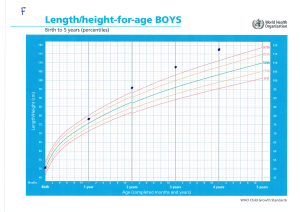Blog
How Tall is A 3 Year Old Child? Journey to Supporting Height Growth from Early Stages
How tall is a 3 year old child is a question many parents ask when beginning the journey of caring for their child’s growth. At this age, height not only reflects health but also serves as the foundation for future growth potential. How can you know if your child is on track and how can you support them to grow taller from an early age? This article provides detailed information about standard height according to WHO, how to track it, and the role of Hito Tall – a functional food from Japan – in helping 3 year old children achieve optimal height development.
1. Standard Height of a 3-Year-Old Child
Age 3 is an important stage in a child’s physical development. According to the World Health Organization (WHO) growth chart, the average height and weight of a 3-year-old are:
– Boys: 94–100 cm tall, 13–15 kg (50th percentile).
– Girls: 92–98 cm tall, 12–14 kg (50th percentile).
Other percentiles in the WHO chart:
– 3rd percentile: Boys under 89 cm, girls under 87 cm (risk of being underdeveloped).
– 97th percentile: Boys over 105 cm, girls over 103 cm (may develop above standard).
If a child is below the 3rd percentile in height, parents should consider adjusting nutrition, physical activity, or consult a doctor to ensure proper development. Understanding how tall is a 3-year-old child helps parents lay the foundation for long-term height growth.

2. Importance of Tracking Height in a 3-Year-Old Child
The period from 0–5 years old, especially at age 3, is when children experience rapid growth in height and weight. According to research from Children’s Hospitals, children who reach standard height at this age are better able to maximize their genetic potential during puberty. Tracking height helps to:
– Assess overall health: Height below the standard may indicate malnutrition or health issues.
– Early intervention: Detect issues such as growth hormone (GH) deficiency or nutritional deficiencies in time.
– Build a foundation: Establish habits for height care early so children can reach their full potential.
3. How to Measure and Track a 3-Year-Old Child’s Height
To accurately know how tall is a 3-year-old child, parents should measure height correctly:
– Tools: Use a tape measure or wall-mounted stadiometer.
– Measurement method: Have the child stand straight with back against the wall, no shoes, eyes looking straight ahead, measure in the morning.
– Frequency: Measure every 3–6 months to track growth trends.
– Compare with WHO chart: Check charts on the WHO website or children’s health apps to evaluate percentiles.
– Practical example: If a 3-year-old boy is 90 cm tall (below the 3rd percentile), parents should review nutrition and consult a doctor for timely adjustments.
4. Nutrition to Help a 3-Year-Old Child Reach Standard Height
Nutrition is the most important factor for children to reach standard height. According to WHO, a 3-year-old child needs:
– Calcium: 700 mg/day from milk, cheese, salmon, spinach, or chia seeds. One 200 ml glass of milk provides 300 mg calcium.
– Vitamin D: 600 IU/day from sunlight (10–15 minutes/day), fatty fish, or supplements.
– Protein: 1–1.5 g/kg body weight from chicken, eggs, tofu. Example: 100 g chicken breast contains 30 g protein.
– Vitamin C: 30–40 mg/day from oranges, kiwi, bell peppers to support collagen synthesis for growth plates.
– Vitamin K2: Helps deposit calcium into bones, found in cheese, egg yolk, or natto.
Sample diet for a 3-year-old child:
– Breakfast: 150 ml milk, oatmeal with banana, 1 boiled egg.
– Lunch: Rice, pan-seared salmon, broccoli soup, 1 slice of orange.
– Dinner: Chicken porridge, mashed sweet potato, steamed greens.
– Snack: Yogurt, a few almonds, or 1 Hito Tall tablet (if approved by a doctor).

5. Hito Tall – Early Height Support Solution
Hito Tall is a functional supplement from Japan, designed to help children from age 3 (with proper dosage and doctor’s guidance) achieve optimal height. Main ingredients:
– Nano Calcium: Absorbed 200 times more efficiently than regular calcium, strengthening and elongating bones.
– Vitamin D3 (600 IU): Increases calcium absorption into bones.
– Vitamin K2 (MK-7): Directs calcium to the right places, preventing accumulation in blood vessels.
– Vitamin C (30 mg): Supports collagen synthesis, increasing growth plate elasticity.
– Magnesium: Supports muscle and bone development.
According to user feedback, children aged 3–5 using Hito Tall (under doctor’s guidance) reach standard height or exceed the 50th percentile after 6 months. The product meets GMP standards and is safe when used at the correct dosage.
How to Use Hito Tall for a 3-Year-Old Child:
– Consult a doctor before use.
– Recommended dosage: 1 tablet/day after meals (for children 6 years and older; children 3–5 years require a lower dose as directed by a doctor).
– Drink 1–1.5 liters of water/day to optimize absorption.
Note: Always consult a doctor before giving Hito Tall to children under 6, especially if the child has underlying conditions such as kidney stones.
Read more:
6. Physical Activity Supports Height in a 3-Year-Old Child
Children aged 3 need gentle exercise to stimulate growth plates and bone development:
– Free running and jumping: 20–30 minutes/day in parks or playgrounds.
– Active games: Hopscotch, climbing low stairs, or light ball games.
– Children’s yoga: Simple poses like Cat-Cow, Tree Pose (10–15 minutes/day) enhance flexibility.
– Tip: Avoid overexertion or heavy lifting to prevent stress on developing bones.
7. Sleep – The Foundation for Height
Growth hormone (GH) is secreted most during deep sleep between 10 p.m. and 2 a.m. For a 3-year-old child:
– Sleep duration: 10–11 hours/night, plus 1–2 hours nap.
– Sleep environment: Dark, quiet room, 20–22°C, use a thin pillow (3–5 cm).
– Routine: Read stories or sing lullabies before bed; avoid screens 1 hour before sleep.
8. Healthy Lifestyle for a 3-Year-Old Child
Create a joyful environment: Less stress promotes better GH secretion. Play with your child or organize outdoor activities.
– Limit sweets: Sugary drinks and candies reduce calcium absorption.
– Sun exposure: 10–15 minutes/day to naturally synthesize vitamin D.
– Stay hydrated: 1–1.5 liters/day (including milk and fruit juice) to support metabolism.

9. Mistakes to Avoid When Supporting a 3-Year-Old Child’s Height
– Not measuring height regularly: Skipping monitoring prevents parents from recognizing early signs of slow growth.
– Imbalanced nutrition: Lack of calcium, vitamin D, or protein slows bone development.
– Insufficient sleep: Sleeping less than 10 hours/night reduces GH secretion.
– Forcing excessive physical activity: Puts pressure on bones and affects growth plates.
10. Conclusion
Understanding how tall a 3-year-old child is the first step for parents to build a solid foundation for their child’s height development. By tracking WHO growth charts, providing balanced nutrition, encouraging gentle exercise, ensuring quality sleep, and using Hito Tall (under doctor’s guidance), you can help your child reach standard height and lay the groundwork for the future. Start your child’s height care journey today to help them grow taller and healthier!
Call to Action: Learn more about Hito Tall on the official website or consult a nutrition expert for detailed guidance. Act now to see your child’s significant development in 6–12 months!
